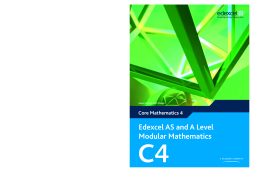
Additional Information
Book Details
Abstract
Edexcel and A Level Modular Mathematics C4 features:
- Student-friendly worked examples and solutions, leading up to a wealth of practice questions.
- Sample exam papers for thorough exam preparation.
- Regular review sections consolidate learning.
- Opportunities for stretch and challenge presented throughout the course.
- ‘Escalator section’ to step up from GCSE.
PLUS Free LiveText CD-ROM, containing Solutionbank and Exam Café to support, motivate and inspire students to reach their potential for exam success.
- Solutionbank contains fully worked solutions with hints and tips for every question in the Student Books.
- Exam Café includes a revision planner and checklist as well as a fully worked examination-style paper with examiner commentary.
Table of Contents
| Section Title | Page | Action | Price |
|---|---|---|---|
| Cover | Cover | ||
| Contents | ii | ||
| About this book | iv | ||
| Chapter 1: Partial fractions | 1 | ||
| 1.1: Adding and subtracting algebraic fractions | 2 | ||
| 1.2: Partial fractions with two linear factors in the denominator | 3 | ||
| 1.3: Partial fractions with three or more linear factors in the denominator | 4 | ||
| 1.4: Partial fractions with repeated linear factors in the denominator | 6 | ||
| 1.5: Improper fractions into partial fractions | 7 | ||
| Summary of key points | 9 | ||
| Chapter 2: Coordinate geometry in the (x, y) plane | 10 | ||
| 2.1: Parametric equations used to define the coordinates of a point | 11 | ||
| 2.2: Using parametric equations in coordinate geometry | 13 | ||
| 2.3: Converting parametric equations into Cartesian equations | 16 | ||
| 2.4: Finding the area under a curve given by parametric equations | 18 | ||
| Summary of key points | 22 | ||
| Chapter 3: The binomial expansion | 23 | ||
| 3.1: The binomial expansion for a positive integral index | 24 | ||
| 3.2: Using the binomial expansion to expand (a+bx)n | 29 | ||
| 3.3: Using partial fractions with the binomial expansion | 31 | ||
| Summary of key points | 35 | ||
| Chapter 4: Differentiation | 36 | ||
| 4.1: Differentiating functions given parametrically | 37 | ||
| 4.2: Differentiating relations which are implicit | 39 | ||
| 4.3: Differentiating the function ax | 41 | ||
| 4.4: Differentiation and rates of change | 42 | ||
| 4.5: Simple differential equations | 43 | ||
| Summary of key points | 50 | ||
| Chapter 5: Vectors | 51 | ||
| 5.1: Vector definitions and vector diagrams | 52 | ||
| 5.2: Vector arithmetic and the unit vector | 56 | ||
| 5.3: Using vectors to describe points in 2 or 3 dimensions | 60 | ||
| 5.4: Cartesian components of a vector in 2 dimensions | 61 | ||
| 5.5: Cartesian components of a vector in 3 dimensions | 64 | ||
| 5.6: Extending 2 dimensional vector results to 3 dimensions | 67 | ||
| 5.7: The scalar product of two vectors | 69 | ||
| 5.8: The vector equation of a straight line | 75 | ||
| 5.9: Intersecting straight line vector equations | 79 | ||
| 5.10: The angle between two straight lines | 81 | ||
| Summary of key points | 85 | ||
| Chapter 6: Integration | 87 | ||
| 6.1: Integrating standard functions | 88 | ||
| 6.2: Integrating using the reverse chain rule | 90 | ||
| 6.3: Using trigonometric identities in integration | 92 | ||
| 6.4: Using partial fractions to integrate expressions | 95 | ||
| 6.5: Using standard patterns to integrate expressions | 98 | ||
| 6.6: Integration by substitution | 101 | ||
| 6.7: Integration by parts | 105 | ||
| 6.8: Numerical integration | 108 | ||
| 6.9: Integration to find areas and volumes | 111 | ||
| 6.10: Using integration to solve differential equations | 114 | ||
| 6.11: Differential equations in context | 117 | ||
| Summary of key points | 127 | ||
| Review Exercise | 129 | ||
| Practice paper | 140 | ||
| Examination style paper | 142 | ||
| Formulae you need to remember | 144 | ||
| List of symbols and notation | 145 | ||
| Answers | 148 | ||
| Index | 160 |
